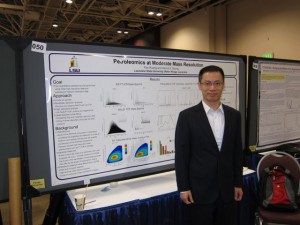





Murray Mass Spectrometry Group
Research group of Kermit Murray at Louisiana State University where we use lasers for sampling and imaging and study the chemistry and physics of laser ablation.






STTR Grant Award, Kermit Murray, PI: Nanoscale Laser Ablation Capture Mass Spectrometry for Single Cell Proteomics, National Institutes of Health, R41 GM106454
S.-G. Park, K.K. Murray, Ambient laser ablation sampling for capillary electrophoresis mass spectrometry, Rapid Commun. Mass Spectrom. 27 (2013) 1673–1680. doi:10.1002/rcm.6618.
RATIONALE: Ambient laser ablation with mass spectrometric detection is a powerful method for direct analysis of biological samples in their native environment. Capillary electrophoresis (CE) can separate complex mixtures of biological molecules prior to mass spectrometry (MS) analysis and an ambient sampling interface for CE/MS will allow the detection of minor components.
METHODS: An infrared (IR) laser ablated and transferred sample materials under ambient conditions for direct loading onto the CE separation column. Samples were deposited on a transparent target and ablated in transmission geometry using a pulsed mid-IR laser. The ablated materials were captured in the exposed sampling solvent and then loaded into a capillary by electrokinetic injection for separation and analysis by electrospray ionization (ESI)-MS.
RESULTS: The system was tested using mixtures of peptide and protein standards. It is estimated that tens of fmol of material was transferred from the ablation target for injection into the CE system and the theoretical plate number was between 1000 and 3000.
CONCLUSIONS: A novel interface for ambient sampling to CE/MS was developed. The interface is generally applicable and has potential utility for mass spectrometry imaging as well as the loading of microfluidic devices from untreated ambient samples.

T. Musapelo, K.K. Murray, Particle production in reflection and transmission mode laser ablation: implications for laserspray ionization, J. Am. Soc. Mass Spectrom. 24 (2013) 1108–1115. doi:10.1007/s13361-013-0631-z.
Abstract: Particles were ablated from laser desorption and inlet ionization matrix thin films with a UV laser in reflection and transmission geometries. Particle size distributions were measured with a combined scanning mobility particle sizer (SMPS) and aerodynamic particle sizer (APS) system that measured particles in the size range from 10 nm to 20 μm. The matrixes investigated were 2,5-dihydroxybenzoic acid (DHB), α-cyano-4-hydroxycinnamic acid (CHCA), sinapic acid (SA), 2,5-dihydroxy-acetophenone (DHAP), and 2-nitrophloroglucinol (NPG). Nanoparticles with average diameters between 20 and 120 nm were observed in both transmission and reflection geometry. The particle mass distribution was significantly different in reflection and transmission geometry. In reflection geometry, approximately equal mass was distributed between particles in the 20 to 450 nm range of diameters and particles in the 450 nm to 1.5 μm diameter range. In transmission mode, the particle mass distribution was dominated by large particles in the 2 to 20 μm diameter range. Ablation of inlet ionization matrices DHAP and NPG produced particles that were 3 to 4 times smaller compared with the other matrices. The results are consistent with ion formation by nanoparticle melting and breakup or melting and breakup of the large particles through contact with heated inlet surfaces.


V. Salla, K.K. Murray, “Matrix-assisted laser desorption ionization mass spectrometry for identification of shrimp,” Anal. Chim. Acta. 794 (2013) 55–59. doi:10.1016/j.aca.2013.07.014.
Abstract: Matrix-assisted laser desorption ionization (MALDI) time of flight mass spectrometry was used to identify shrimp at the species level using commercial mass spectral fingerprint matching software (Bruker Biotyper). In the first step, a mass spectrum reference database was constructed from the analysis of six commercially important shrimp species: Litopenaeus setiferus, Farfantepenaeus aztecus, Sicyonia brevirostris, Pleoticus robustus, Pandalopsis dispar and Pandalus platyceros. This step required a desalting procedure for optimum performance. In the second step, the reference database was tested using 74 unknown shrimp samples from these six species. Correct identification was achieved for 72 of 74 samples (97%): 72 samples were identified at the species level and 2 samples were identified at the genus level using the manufacturer’s log score specifications. The MALDI fingerprinting method for the identification of shrimp species was found to be reproducible and accurate with rapid analysis.

LSU Chemistry Professor Secures NIH Grant for Single Cell Analysis Research
LSU Research News
Grant is one of 15 high risk, high impact projects funded nationally
Kermit Murray, LSU professor of chemistry, was awarded $350,844 to develop new methods for single cell analysis. The goal of Murray’s project, entitled, Nanoscale Laser Ablation Capture Mass Spectrometry for Single Cell Proteomics, is to create nanometer scale sampling for mass spectrometry using near-field optics and laser ablation.
“An ensemble of cells does not give us a detailed look at cells,” said Murray. “You may have 100 cells and only a few of them will be in a particular disease state. The use of mass spectrometry will give us a high-resolution view of cells at a sub-cellular level.”
Single cell analysis emerged as an important field of research after new technologies with improved sensitivity made it possible to measure cell-to-cell differences in living organisms and correlate the variation with changes in biological function and disease.
Murray’s research was one of only 15 high-risk/high-impact projects funded nationally to develop new tools to enhance measurement parameters such as sensitivity, selectivity, spatiotemporal resolution, scalability and/or non-destructive measures that preserve the integrity of the cell. The new tools will also improve capabilities for the simultaneous measurement of multiple molecular components, such as genes and cells, within a single cell.
Advancements in single cell analysis will allow personalized health care at the cellular level. Research could lead to the development of techniques to identify genomic lesions in individual cancer cells, which would improve the early detection of rare tumor cells, allow better monitoring of circulating tumor cells and guide chemotherapy treatments.
“This was an extremely competitive grant program. I was really surprised that we scored as well as we did,” said Murray. “It is a very prestigious award and I am glad to bring such quality research to LSU and the state of Louisiana.”
The Single Cell Analysis Program is funded through the Common Fund, and managed by the NIH Office of the Director in partnership with the National Institute of Biomedical Imaging and Biotechnology, or NIBIB, and National Institute of Mental Health, or NIMH, both part of NIH.
The NIH Common Fund encourages collaboration and supports a series of exceptionally high impact, trans-NIH programs. Common Fund programs are designed to pursue major opportunities and gaps in biomedical research that no single NIH Institute could tackle alone, but that the agency as a whole can address to make the biggest impact possible on the progress of medical research. Additional information about the NIH Common Fund can be found at http://commonfund.nih.gov.
NIBIB’s mission is to support multidisciplinary research and research training at the crossroads of engineering and the biological and physical sciences. NIBIB supports emerging technology research and development within its internal laboratories and through grants, collaborations, and training. More information is available at the NIBIB website: http://www.nibib.nih.gov/.
The mission of NIMH is to transform the understanding and treatment of mental illnesses through basic and clinical research, paving the way for prevention, recovery and cure. More information is available at the NIMH Web site, http://www.nimh.nih.gov.
About the National Institutes of Health:
NIH, the nation’s medical research agency, includes 27 Institutes and Centers and is a component of the U.S. Department of Health and Human Services. NIH is the primary federal agency conducting and supporting basic, clinical, and translational medical research, and is investigating the causes, treatments, and cures for both common and rare diseases. For more information about NIH and its programs, visit http://www.nih.gov/.
S.-G. Park, K.K. Murray, “Infrared laser ablation sample transfer for on-line liquid chromatography electrospray ionization mass spectrometry,” J. Mass Spectrom. 47 (2012) 1322–1326. doi:10.1002/jms.3096.

We have demonstrated an on-line laser ablation sampling system and coupling of the system to liquid chromatography (LC) using an infrared (IR) laser to ablate and transfer materials into a flowing solvent stream. With this approach, samples are deposited on a microscope slide mounted on a translation stage and ablated in transmission geometry using a pulsed mid-IR laser. The ablated material is captured in an exposed flowing solvent stream that carries the ablated material to the electrospray source. Post-ablation separation is accomplished using a capillary column downstream of the capture zone. The performance of the system was assessed using peptide and protein mixtures ablated from the target and analyzed with and without LC separation.